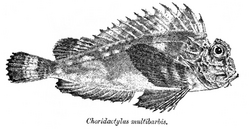Biology:Choridactylus
| Choridactylus | |
|---|---|

| |
| Orangebanded stingfish (C. multibarbus) | |
| Scientific classification | |
| Domain: | Eukaryota |
| Kingdom: | Animalia |
| Phylum: | Chordata |
| Class: | Actinopterygii |
| Order: | Scorpaeniformes |
| Family: | Scorpaenidae |
| Tribe: | Choridactylini |
| Genus: | Choridactylus J. Richardson, 1848 |
| Type species | |
| Choridactylus multibarbus Richardson, 1848[1]
| |
| Synonyms[1] | |
| |
Choridactylus is a genus of marine ray-finned fishes, it is one of two genera in the tribe Choridactylini, one of the three tribes which are classified within the subfamily Synanceiinae within the family Scorpaenidae, the scorpionfishes and their relatives. They are commonly known as stingfishes. They are found in the Indo-West Pacific.
Taxonomy
Choridactylus was first described as a genus in 1848 by the Scottish naval surgeon, Arctic explorer and naturalist John Richardson as a monotypic genus. Its only species was Choridactylus multibarbus which Richardson had also described in 1848 with its type locality given as the “Sea of China”.[1][2] It is one of two genera in the tribe Choridactylini within the subfamily Synanceiinae of the family Scorpaenidae.[3] However, some authorities classify this taxon as a subfamily Choridactylinae within the family Synanceiidae.[1] The generic name is made up of choris, meaning "separated", and dactylus, which means "finger", and allusion to the detached pectoral fin rays of C. multibarbus, a feature which “readily distinguished” it from other stonefishes known to Richardson.[4]
Species
There are currently four recognized species in this genus:[5]
- Choridactylus lineatus Poss & Mee, 1995 (Lined stingfish)
- Choridactylus multibarbus J. Richardson, 1848 (Orangebanded stingfish)
- Choridactylus natalensis (Gilchrist, 1902) (Threestick stingfish)
- Choridactylus striatus Mandritsa, 1993
Characteristics
Choridactylus stingfishes have 12-15 spines and 8-10 soft rays in the dorsal fin with 2 spines and 8-10 soft rays in the anal fin. The pectoral fins have 12 fin rays with the 3 lower rays being separated. They have small blunt heads with bulging eyes with an occipital depression. The mouth is small and slightly oblique with villiform teeth on the jaws with no vomerine teeth or palatine teeth. The body has small tentacles or skin flaps on the lower jaw, eye, spiny dorsal fin and spiny anal fin. There are tufts on the lateral line and upper body.[6] These fishes vary in size from a total length of 14 cm (5.5 in) in C. multibarbus and C. natalensis to 25 cm (9.8 in) in C. lineatus.[5]
Distribution and habitat
Choridactylus stingfishes are found in the Indian and Pacific Oceans, C. multibarbus is widespread reaching from Red Sea to the Philippines but the other three species are restricted to the western Indian Ocean.[5] These fishes occur in shallow waters over sandy substrates.[6]
References
- ↑ 1.0 1.1 1.2 1.3 Eschmeyer, William N.; Fricke, Ron; van der Laan, Richard, eds. "Genera in the family Choridactylinae". California Academy of Sciences. http://researcharchive.calacademy.org/research/ichthyology/catalog/fishcatget.asp?tbl=genus&family=Choridactylinae.
- ↑ Eschmeyer, William N.; Fricke, Ron; van der Laan, Richard, eds. "Species in the genus Choridactylus". California Academy of Sciences. http://researcharchive.calacademy.org/research/ichthyology/catalog/fishcatget.asp?tbl=species&genus=Choridactylus.
- ↑ J. S. Nelson; T. C. Grande; M. V. H. Wilson (2016). Fishes of the World (5th ed.). Wiley. pp. 468–475. ISBN 978-1-118-34233-6. https://sites.google.com/site/fotw5th/. Retrieved 2022-04-05.
- ↑ Christopher Scharpf; Kenneth J. Lazara, eds (10 March 2022). "Order Perciformes (Part 10): Suborder Scorpaenoidei: Families Apistidae, Tetrarogidae, Synanceiidae, Aploacrinidae, Perryenidae, Eschmeyeridae, Pataceidae, Gnathanacanthidae, Congiopodidae and Zanclorhynchidae". The ETYFish Project Fish Name Etymology Database. Christopher Scharpf and Kenneth J. Lazara. https://etyfish.org/perciformes10/.
- ↑ 5.0 5.1 5.2 Froese, Rainer and Pauly, Daniel, eds. (2022). Species of Choridactylus in FishBase. February 2022 version.
- ↑ 6.0 6.1 Eschmeyer, W. N.; Hallacher, L. E.; Rama-Rao, K. V. (1979). "Fishes of the Scorpionfish subfamily Choridactylinae From the Western Pacific and Indian Oceans". Proceedings of the California Academy of Sciences 41 (21): 475-500. https://www.biodiversitylibrary.org/page/15691916#page/509/mode/1up.
Wikidata ☰ Q2358149 entry
 |

